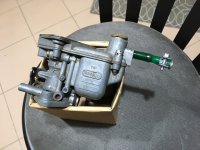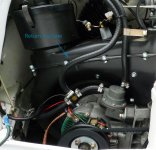The fuel should not ever rise to the top of the float chamber. A leak shows the fuel is too high. Causes can be: the float valve not seating properly due to wear, dirt, or excess pressure; Float holed or porous, or pivot sticking; cracked top cover. (There may be others)
As all seemed ok until you plugged the return line, excess pressure would be the most likely cause. DO NOT add an extra gasket, as this will effectively raise the normal fuel level, causing it to always run rich.
As a rule of thumb, carburettors are normally fed with about 4psi of pressure. A pump mounted close to the engine will have a good suck, but only a light push, whereas a pump fitted close to the tank will usually have only a light suck, but a good push. This can cause problems when fitting an electric pump and using the wrong one.
A mechanical pump attached to the engine has a diaphragm with a spring under it. The lever is pushed by the camshaft to pull the diaphragm down to suck fuel in. The spring creates the pressure for the output, resisted by the float valve when the chamber is full. As the float drops, more fuel is moved, until the diaphragm reaches the top of its travel, and the lever contacts the cam again and pulls more through. In practice it only moves gently down and up near the middle of its range.
If the carb only has an inlet, pressure from the pump should not exceed about 4psi. But if a return line is used, often the pump will deliver higher pressure and flow, to circulate the fuel. The float valve is not stressed as the pressure is not bearing on it directly, as the flow rate is more important. The carb return outlet is usually a smaller hole as a restrictor.
If the pump is of the higher pressure/flow rate type, plugging the return can lead to the float valve being pushed off its seat, overfilling the float chamber, causing rich running and leaks.
Fixes:
Put a return hose back into the system.
Source a pump with a lower output. There may be differnt models without the return line, so their pump would be different, so might be a straight swap. If changing pumps, pay particular attention to lever position, length and travel, and the fitting of the pump to the block, as there are often spacers, and the thickness of these varies according to pump lever and camshaft relative positions. Get it wrong and levers can snap, cams can wear, etc. Or just no fuel delivery!
Just wishing to lose one pipe from the engine bay seems to create a lot of work. My advice, put it back to standard. Fiat probably knew what they were doing. The return pipe added cost, so there must have been a very good reason to have one.



